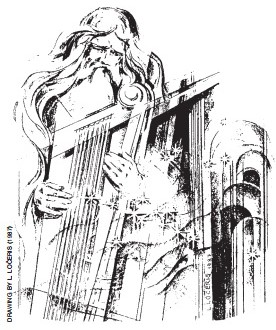by Janina Birutė Litvinas

The Lithuanian Song Festival tradition in America is almost as old as Lithuanian immigration itself. From its early beginnings in 1914, this tradition has continued almost uninterrupted to this day.
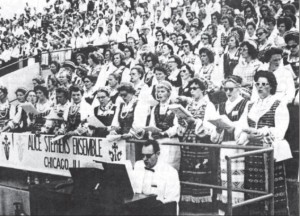
MY ALMOST SACRED RELIC, A TRAVEL BOOK from my Father’s library, Lithuania, Guiding Facts for Tourists, published for English speaking travelers in 1930 by The Automobile Club of Lithuania, contains a myriad of fascinating facts such as rates of exchange, for one dollar – 10 litai; addresses and cost of hotels, first class – 8-32 litai; how to find restaurants, garages, how to get to them by car, and describes what to see in each city. The introduction to this adventure entitled “Land of Northern Gold and its People,” contains a commentary which begins with “…through all their vicissitudes the Lithuanians guarded three precious things: the first – language, a sister tongue of Sanskrit and the oldest Indo-European language extant today. The second – a love of and kinship with nature rarely found in anyone else in present day Europe. The third – a keen appreciation of the beauty found in every day life which caused the Lithuanian to make of his whole life a living poem, in thousands and thousands of variations called ‘dainos.’”
This sentence about “life as a living poem” came to mind as I drove home from a practice session in a cold, damp classroom at St. George’s Lithuanian Roman Catholic Church in Rochester, New York, where the Putinas’ Choir Director, Raimundas Obalis, with great patience, worked with the repertoire for the VIII Lithuanian Song Festival in Chicago, Illinois, on July 2, 2006. The reason we were there, as were the hundreds of other choirs in USA and Canada who were now meeting and working with the same repertoire, was that we knew intuitively that singing of these “dainos” was our most important weapon passed down from generation to generation against our extinction, against apathy, against dissolution. That singing of these “dainos” was an affirmation, an acknowledgment to ourselves and to our children that on this side of the ocean from Lithuania we are alive, proud of who we are, and intent to say so when we come together for the VIII Song Festival to express this with the most precious thing we have, a Lithuanian song.
Lithuanians who came to America always knew this. As early as 1914 on September 24, all the parish choirs in Chicago joined together in what Juozas Žilevičius in his book, Lithuanian Organist Abroad, called the First Song Festival, to perform Česlovas Sasnauskas’ cantata, Brothers. And, 1930 brings a joined choir of 1,000 singers for the 500th anniversary of Lithuania’s Grand Duke Vytautas’ death. The 1935 first official Song Festival registered 12 choirs who performed in Vytautas Park in Chicago. And, at the 1939 World’s Fair in New York at the designated Lithuanian Day, 59 choirs with 2,848 singers, dressed in national costumes performing the whole repertoire from memory, drew an unprecedented number of listeners. All of this in the face of the hardships that the thousands of immigrants from Lithuania faced. But, they spared no effort because they knew that the songs learned at home and sung in their native language gave solace and hope and spiritual life, bringing them back to the world and the people they loved.
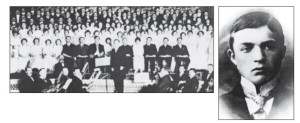
“The spirit of ‘modern progress,’ enemy of so much that is simple but beautiful, has touched Lithuania as it has every other land and many beautiful customs are slowly dying out. But one of the things it has not been able to wean the Lithuanian from is his love of song. Lithuania to this day is a singing nation to a much greater degree than is usually meant by the term.”
The Second World War devastated Lithuanians on both sides of the Atlantic. The first wave of post-war Lithuanian immigrants who came to the USA in 1948, without exception formed choirs. Other organizations followed, but it was in the choir practice, after working at jobs for which they were overqualified, without knowing English well enough to communicate, that they could pour out their longing and their sorrows and joys in a song. It is in the choir practice that they found familiar surroundings and purpose and each other. Knowing this, in 1953 the ALRK Organist Convention proposed an idea, which was to become a reality in 1956 as a Song Festival in Chicago. Alice Stephens was the head of the Organizing Committee, and when the Honorary Conductor, Juozas Žilevičius, who had organized the first Song Festival in Kaunas in 1924 called “Song Day,” raised his baton, 34 choirs with 1,200 singers responded. Music critic Vladas Jakubėnas wrote: “The program was faithfully learned. The day of the concert the weather suddenly changed from a cool day to a scorching over a 100-degree oven. The heat in the sold-out hall, which had no air conditioning, was unbearable. But, it held a moral victory – American and Canadian Lithuanians accomplished a major job, whose success will raise our self-esteem and will inspire us even more to hold on and to develop our national culture.”
“Whenever a group of people, especially young folks come together for work or play, they sing. The ploughman sings of his straight furrow and the larks that circle above his head; the sower sings of the promise of his seed; the reapers of the beauty of the golden grain and the harvest festival; the raftsmen, bringing huge rafts down the rivers sing of the deep forests from which they come, of the dangers of the way.”
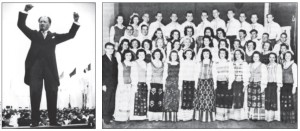
a 2,848-member chorus at the 1939 New York World’s Fair. ABOVE: The Knights of Lithuania chorus in Chicago, 1948, directed by Prof. Dr. Leonardas Šimutis.
The II Song Festival came five years later in 1961 and was organized under the auspices of the Lithuanian-American Communities of USA and Canada. Rev. Ignas Albavičius was the head of the committee and Aleksandras Aleksis received the Honorary Conductor’s baton from Juozas Žilevičius to direct the US and Canadian national anthems. The Chicago Amphitheatre was host to 23 choirs, 1,000 singers and more than 10,000 listeners. Composer Vladas Jakubėnas wrote, “The song festival cannot be held as being only a concert. It is a declaration of unity of our nation. Jakubėnas’ composition, “Hymn of the Banished and Exiled,” words by Bernardas Brazdžionis, sung at the Festival and as agreed by many, should have been entitled “Psalm of the Lithuanian Nation.”
“Girls, watering the long strips of linen bleaching in the sun, sing of the dower chest they are preparing; working in their gardens they sing of their wreaths of rue, symbol of their maidenhood, and comparing life of their flowers, they lament its brevity. Old women at their spinning wheels sing of the loving care with which they brought their children up and the emptiness of the home nest now that the young ones have flown.”
In the 1966 III Song Festival, 41 choirs including 16 children’s choirs brought together 1,200 singers and 11,000 listeners. The Festival’s culmination point included a commissioned work by composer Bronius Budriūnas, a cantata entitled “My Home in My Native Land.” The Kanklių orchestra, directed by Ona Mikulskis, who had been a participant in the 1924 Kaunas’ “Song Day,” added to the character of the songs, and many in the audience agreed that the number and the interpretation of the songs by the children’s choir were outstanding. In 1971, Bronius Budriūnas’ cantata, “In Lithuania’s Enlightened Road,” highlighted The IV Song Festival in the International Chicago Amphitheatre.
“The orphan girl walking along the stony road sympathizes with the stones, which surely must suffer from the heavy wheels which pass over them and compares her lot to theirs; in the cuckoos’ sad plaint she hears her mother’s voice. Shepherds sing of their animals or celebrate the weddings or wars of birds and beasts or beg the rain clouds kindly to go to Russia or Prussia.”
In 1978 the V Song Festival was transferred from Chicago, where most Lithuanians lived, to Toronto, Canada. This festival had many innovations: the Song Festival Flag, combined Kanklių Orchestra, Lithuanian choir from Melbourne, Australia, and a symphony orchestra. The festival drew 51 choirs and 1,400 singers. A Lithuanian Folk Song Instrumental Orchestra accompanied some of the songs. Musician Algis Šimkus wrote, “Hospitable Toronto brought together thousands of Lithuanians and gave them new reasons to be proud of their heritage.” In the VI Song Festival of 1983, again in Chicago and commemorating the 50-year anniversary of the flight of Darius and Girė- nas, the combined choirs sang a work by Emerikas Gailevičius, “Lituanica.” Folk dancers joined the Festival with three folk dances accompanied by an instrumental orchestra and the choir. President Ronald Reagan greeted everyone by phone.
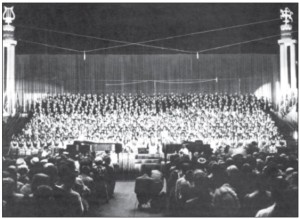
“Children wondering the woods sing of the ‘Colonel of all the Mushrooms’ they hope to find or else relate the sad history of the owl – its hatching, appearance, unfortunate illness, death, and imposing funeral. There are songs about everything and for every occasion; nothing is too great or too small to have a song made about it.”
In 1991, the year of the Restoration of Lithuania’s Independence, the VII Song Festival brought together 200 children, 200 folk dancers, but only 500 singers. Many acknowledged the reasons for a reduction in the number of singers. American and Canadian culture, which relegates singing to a birthday song, infringed on the second and third generation of Lithuanian Americans and Lithuanian Canadians. Children, who were not exposed to singing as part of a family’s tradition, did not feel comfortable when their Lithuanian parents or grandparents started to sing, let alone joined a choir. Also, there was no one to explain to them what the songs meant because fewer and fewer singers had the experience to do so. Joining a choir was relegated to the end as one activity and not as the most important part of a one’s life. Thus, a combined Song Festival in a free Lithuania seemed to be the answer to everything. But, mostly, only those from “choir families” made an effort to participate. Those who did go to Lithuania to sing in the Song Festival found themselves following a format developed through many years of Song Festivals held under Soviet domination. And, the singers who did come were separated from the rest of the Lithuanian choirs, maybe because of the honor always given to Lithuania’s guests; maybe because the Lithuanian hosts did not know how to integrate these strange people, coming from a different part of the world who spoke the same language but brought a nostalgia which those in Lithuania did not understand.
Whatever the reasons, most of us who sang all our lives in a choir felt sadness at the abandonment of the tradition of Song Festivals in North America and wondered why a historical tradition of having festivals on both sides of the Atlantic could not be followed. It was up to the great visionary, Algimantas Gečys, then the President of the Lithuanian-American Community, Inc., to propose an idea to bring back the Song Festivals to North America. The coming together of choirs for a Song Festival in North America now is answering the same need as it did for those Lithuanians living in America in 1914: to reaffirm that singing is an integral part of Lithuania’s culture; that through singing a Lithuanian expresses his joys and sorrows, expresses his and his countrymen’s longing and values. Living in another culture, he remains true to himself and his heritage by singing the songs his forefathers did.
“But perhaps the most beautiful impression of all is left by the songs heard at eventide, on summer days, when young people, after a day’s work is done, go down to the rivers and lakes to bathe. Wonderfully beautiful is the singing, with campfires and grazing horses nearby.”
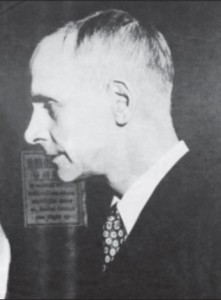
And, so, in a couple of months, after 15 years of absence over 1,000 singers will again make a journey to Chicago because Rita Kliorienė, agreeing to become the Artistic Director, so ably picked up the challenge with the help of Audrius Polikaitis as the Organizing Committee’s Chair. This time first, second, and third generations of Lithuanian Americans and Lithuanian Canadians will be joined by Lithuanians who immigrated after Independence. Explaining the need for a Song Festival is the title so aptly chosen for the VIII Song Festival: Respond with a Song. Respond with a song to the world that those of us living in North America have our own face, born out of years of explaining in schools and jobs who we are, nurtured by the stories told by our parents and grandparents, instructed by heroes whose names we learned in Saturday schools, sustained by the songs at Scout and Student camps and each other. Respond to our homeland that we are one in that which unites us, a Lithuanian song. That is why there should be no one, who has the opportunity, who will not be at the VIII Song Festival either as a participant or in the audience. We must respond to the organizers’ invitation to come to the VIII Song Festival by giving witness to a 92-year tradition in North America that says we are alive, we are here, and we take great pride in being a part of a Singing Nation – Lithuania.
“In his land every hill, every lake, river, grove; every bird, beast, tree and flower – even the very stones have their legend, their song. His foreign rulers may have despised him, but he knew that Saulė, the sun, was his mother; Mėnulis, the moon, his father; the stars his brothers and sisters; the birds and beasts and spirits of forest and hill and stream were his friends who rejoiced and sorrowed with him. He made a song of his work and of all the joys and grieves of his life.”
 DRAUGAS NEWS Lithuanian World Wide News in English
DRAUGAS NEWS Lithuanian World Wide News in English
